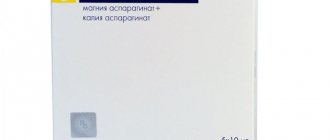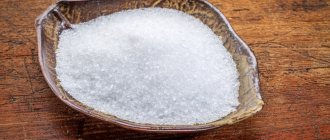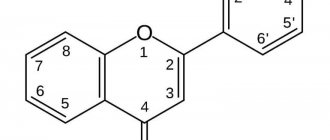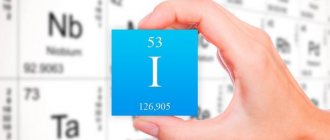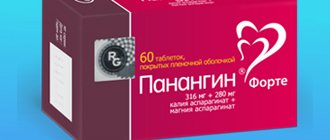Today we will discuss the rules for taking our expensive drug - Panangin.
Let's look at the question - how to take it correctly, let's touch on the topic of hangover and the role of our medicine in this process. There are sections that are also present in the instructions for this drug, located on my blog, this was done intentionally. Everyone who reads this article can study the issue comprehensively, without gaps; those who want to read the instructions themselves can follow the link above, or find it in the site navigation, it is intuitively easy and understandable. So, the beginning of the article is already under this line, happy reading and good health!
A lack of potassium and magnesium in the body leads to the development of arrhythmia, the functioning of the heart muscles is disrupted, and blood pressure increases. For these reasons, panangin is prescribed for the treatment of heart and vascular diseases. This product contains microelements necessary for the body. It is important to know how to take Panangin correctly for prevention.
pharmachologic effect
A drug that affects metabolic processes. Source of potassium and magnesium ions.
Potassium and magnesium are intracellular cations that play a major role in the functioning of many enzymes, the interaction of macromolecules and intracellular structures, and in the mechanism of muscle contractility. The intra- and extracellular ratio of potassium, magnesium, calcium and sodium ions affects myocardial contractility. A low level of potassium and/or magnesium ions in the internal environment can have a proarrhythmogenic effect, predisposing to the development of arterial hypertension, atherosclerosis of the coronary arteries and the occurrence of metabolic changes in the myocardium.
One of the most important physiological functions of potassium is maintaining the membrane potential of neurons, myocytes and other excitable structures of myocardial tissue. An imbalance between the intra- and extracellular potassium content leads to a decrease in myocardial contractility, the occurrence of arrhythmia, tachycardia and increased toxicity of cardiac glycosides.
Magnesium is a cofactor in more than 300 enzymatic reactions in energy metabolism and the synthesis of proteins and nucleic acids. Magnesium reduces contractile tension and heart rate, leading to a decrease in myocardial oxygen demand. Magnesium has an anti-ischemic effect on myocardial tissue. Decreased contractility of smooth muscle myocytes in the walls of arterioles, incl. coronary, leads to vasodilation and increased coronary blood flow.
The combination of potassium and magnesium ions in one preparation is justified by the fact that potassium deficiency in the body is often accompanied by magnesium deficiency and requires simultaneous correction of the content of both ions in the body. With simultaneous correction of the levels of these electrolytes, an additive effect is observed, in addition, potassium and magnesium reduce the toxicity of cardiac glycosides without affecting their positive inotropic effect.
When is the drug prescribed?
Panagin is used for the following diseases and conditions of the patient.
- Hypokalemia.
- Heart attack.
- Hypomagnesemia.
- Heart failure.
- Diarrhea.
- Prolonged vomiting.
- Paroxysmal tachycardia.
- Intoxication.
- Supraventricular tachycardia.
Glucocorticosteroid drugs
Panangin is prescribed for use of glucocorticosteroid drugs, diuretics, and laxatives.
The drug will help close open heart defects in infants and strengthen their heart muscles. It is also prescribed to children to relieve seizures that are associated with a lack of potassium and magnesium.
Today, Panangin is quite often prescribed to people over 45 years of age, as well as:
- For patients with diabetes mellitus, to prevent complications in the organ.
- Patients who are losing weight drink laxatives and diuretics.
- Women who take hormonal contraceptives.
- For those who suffer from cramps and pain in the muscles of the calves.
- As a preventative measure for heart complications due to influenza and other infections.
- For people visiting baths and saunas.
Pharmacokinetics
Suction -
When taken orally, absorption of the drug is high.
Removal -
excreted in urine.
Magnesium in food
Magnesium
. The total supply of magnesium in the body of a person weighing 70 kg is on average 24 g (1000 mmol); more than 60% of magnesium comes from bone tissue and about 40% from skeletal muscle and other tissues. About 1% of the total magnesium reserve in the body is found in extracellular fluid, mainly in blood plasma. In healthy adults, plasma magnesium levels range from 0.7 to 1.10 mmol/L.
The recommended dietary intake of magnesium for men is 350 mg/day, for women - 280 mg/day. The need for magnesium increases during pregnancy and breastfeeding.
Magnesium is absorbed into the gastrointestinal tract by active transport. The main regulator of magnesium balance in the body is the kidneys. 3–5% of ionized magnesium is excreted by the kidneys.
An increase in urine volume (for example, during therapy with highly effective loop diuretics) leads to an increase in the excretion of ionized magnesium. If absorption of magnesium in the small intestine is reduced, further hypomagnesemia leads to decreased excretion (<0.5 mmol/day).
Products containing potassium
Potassium
. The total potassium reserve in the body of a person weighing 70 kg is on average 140 g (3570 mmol). Its amount is slightly less in women than in men, and decreases slightly with age. 2% of the total potassium reserve in the body is located outside the cells, and the remaining 98% is inside the cells.
The optimal dietary intake of potassium is 3–4 g (75–100 mmol) per day. The main route of potassium excretion is renal (about 90% of potassium is excreted by the kidneys per day). The remaining 10% is excreted through the gastrointestinal tract. Thus, the kidneys are responsible for long-term potassium homeostasis as well as plasma potassium levels. In the short term, blood potassium levels are also regulated by the exchange of potassium between the intracellular and extracellular spaces.
Data on the pharmacokinetics of the drug in the form of a solution for intravenous administration are not provided.
Is Panangin contraindicated for pregnant women?
There are no direct contraindications to the use of the medicine during pregnancy, but it should be used with extreme caution during this delicate period, only under the supervision of a leading doctor.
Features of use during pregnancy:
- Panangin should be used only on the recommendation of a specialist, in case of emergency;
- to prevent excess electrolytes in the body during therapy, laboratory blood tests should be carried out regularly;
- It is recommended for pregnant women to prescribe the drug in tablet form; injections are used less frequently;
- if even minor signs of intolerance to Panangin develop, the medication should be abandoned;
- When prescribing a drug, the doctor must take into account the drug interactions of the drug being described.
Any medications during pregnancy are taken only under the supervision of a doctor.
Every woman should remember that any medications during pregnancy can cause negative consequences for her body and the health of the child. Using Panangin on your own or changing its dosage is strictly prohibited.
Dosage regimen
For oral administration
Prescribe 1-2 tablets. 3 times/day. The maximum daily dose is 3 tablets. 3 times/day.
The drug should be used after meals, because the acidic environment of the stomach contents reduces its effectiveness.
The duration of therapy and the need for repeated courses are determined by the doctor individually.
For intravenous administration
The drug is prescribed intravenously as a slow infusion. A single dose is 1-2 ampoules; if necessary, repeated administration is possible after 4-6 hours.
To prepare a solution for intravenous infusion, the contents of 1-2 amps. dissolve in 50-100 ml of 5% glucose solution.
Instructions for use of Panangin (Method and dosage)
Panangin tablets, instructions for use
How to take the medicine? The drug is taken orally three times a day, 2 tablets. Maintenance and preventive therapy: 1 tablet three times a day, course for 3-4 weeks. In some situations, a repetition of the course of therapy is required.
Instructions for intravenous use
Panangin solution is injected intravenously, slowly. The drug is administered at a rate of 20-30 drops per minute, 1-2 times a day, 300 ml. Dosing of the drug Panangin during pregnancy is carried out according to the standard regimen of medication use.
Children can take the medicine from birth.
How to take Panangin for prevention?
If you ask the question of the benefits and harms of Panangin, you should realize that this is a drug that has its own side effects, so you should not use it for prevention. Firstly, in this way you accustom the body to a high content of magnesium and potassium, and secondly, you can provoke an overabundance of these substances, which in turn can cause a lot of negative reactions.
Side effect
When taken orally
From the central nervous system and peripheral nervous system:
possible paresthesia (caused by hyperkalemia); hyporeflexia, convulsions (caused by hypermagnesemia).
From the cardiovascular system:
possible AV blockade, paradoxical reaction (increased number of extrasystoles), decreased blood pressure; redness of the facial skin (due to hypermagnesemia).
From the digestive system:
Possible nausea, vomiting, diarrhea (including those caused by hyperkalemia), a feeling of discomfort or burning in the pancreas (in patients with anacid gastritis or cholecystitis).
From the respiratory system:
possibly respiratory depression (due to hypermagnesemia).
Other:
feeling of heat (due to hypermagnesemia).
With intravenous administration
With rapid intravenous administration, symptoms of hyperkalemia (fatigue, myasthenia gravis, paresthesia, confusion, cardiac arrhythmia / bradycardia, AV block, arrhythmias, cardiac arrest) and hypermagnesemia (decreased neuromuscular excitability, gagging, vomiting, lethargy) may develop. , decreased blood pressure). It is also possible to develop phlebitis, AV block and a paradoxical reaction (increased number of extrasystoles).
Indications
The scope of the medicine is quite limited. Panangin is prescribed to patients for the following conditions:
- myocardial infarction;
- heart rhythm disturbances;
- chronic cardiac pathologies;
- treatment of side effects while taking cardiac glycosides;
- arterial hypertension.
Panangin is prescribed for pathologies of the cardiovascular system
Panangin is prescribed mainly as a complex therapy. The product is well tolerated by patients, has positive reviews, and when used correctly, rarely causes side effects.
Contraindications for use
For oral administration
- acute and chronic renal failure;
- hyperkalemia;
- hypermagnesemia;
- Addison's disease;
- AV blockade I-III degree;
- cardiogenic shock (BP <90 mm Hg);
- myasthenia gravis;
- violation of amino acid metabolism;
- hemolysis;
- acute metabolic acidosis;
- dehydration of the body.
With caution:
during pregnancy (especially in the first trimester) and during lactation.
For intravenous administration
- acute and chronic renal failure;
- hyperkalemia;
- hypermagnesemia;
- Addison's disease;
- AV blockade II-III degree;
- cardiogenic shock (BP <90 mm Hg);
- myasthenia gravis;
- dehydration;
- adrenal insufficiency;
- age under 18 years (efficacy and safety have not been established);
- pregnancy;
- lactation period;
- hypersensitivity to the components of the drug.
Carefully :
with AV blockade of the first degree, severe liver dysfunction, metabolic acidosis, risk of edema, impaired renal function if regular monitoring of magnesium content in the blood serum is impossible (risk of cumulation, toxic magnesium content), hypophosphatemia, urolithiasis associated with impaired metabolism of calcium, magnesium and ammonium phosphate.
Opinions of patients and doctors
Reviews about the drug "Panangin" are mostly positive. Patients indicate good results after completing the course of treatment. The product improves the functioning of the myocardium and relieves convulsions. Reviews confirm that Panangin is really a good pill for the heart.
They can be used during pregnancy, and doctors indicate a good effect. If necessary, the medicine is prescribed to children of any age. A cheaper analogue of the drug is the drug “Asparkam”, which has a similar composition and mechanism of action.
Doctors point to the poor compatibility of the medication with alcohol. Firstly, if you have heart problems, drinking alcohol is not recommended. Secondly, alcohol and Panangin can cause vascular spasms. Sometimes tablets are taken for a hangover; they replenish the potassium and magnesium the body needs in this state.
special instructions
The drug should be prescribed with caution to patients with an increased risk of developing hyperkalemia. In this case, it is necessary to regularly monitor the level of potassium ions in the blood plasma.
Before taking the drug, the patient should consult a doctor.
With rapid intravenous administration of the drug, skin hyperemia may develop.
Impact on the ability to drive vehicles and operate machinery
The drug does not affect the ability to drive a car or engage in activities that require increased concentration and speed of psychomotor reactions.
Opinions
Reviews from cardiologists about Panangin on Internet resources are, as a rule, positive. Patients note the medication as truly effective, which improves the functioning of the heart and eliminates seizures.
The drug helps well with diseases that are caused by a lack of magnesium and potassium in the body. In particular, the drug helps speed up recovery after a concussion, eliminates cramps of the lower extremities, and stabilizes the functioning of the heart.
Most of the reviews concern how to properly drink Panangin for cardiac diseases. People who took the drug noted that during therapy their tolerance to emotional and physical stress significantly improved, signs of tachycardia and a number of other unpleasant symptoms disappeared, and laboratory parameters returned to normal.
We hope this article will be useful to you.
Overdose
Symptoms:
with intravenous administration - hyperkalemia, hypermagnesemia; when taken orally, cardiac conduction disturbances occur (especially if there is pathology of the cardiac conduction system at the time of drug administration).
Treatment:
discontinuation of the drug, symptomatic therapy (iv administration of 100 mg/min calcium chloride solution), if necessary, hemodialysis and peritoneal dialysis.
Cases of overdose are unknown. Given the ability of the kidneys to excrete large amounts of potassium from the body, increasing the dose of the drug can lead to hyperkalemia only if this is associated with an acute or severe impairment of potassium excretion.
The therapeutic index of magnesium is wide, and in the absence of renal failure, severe side effects are extremely rare.
Scientific evidence suggests that taking magnesium supplements orally may cause minor side effects such as diarrhea.
High doses of Panangin may cause increased bowel movements due to the magnesium content.
In case of rapid intravenous administration, symptoms of hyperkalemia/hypermagnesemia may appear.
Symptoms of hyperkalemia: general weakness, paresthesia, bradycardia, paralysis. Extremely high concentrations of potassium in the blood plasma can lead to death from cardiac depression, arrhythmia, or cardiac arrest.
Symptoms of hypermagnesemia: nausea, vomiting, drowsiness, hypotension, bradycardia, weakness, slurred speech, double vision. At very high plasma concentrations of magnesium, hyporeflexia, muscle paralysis, respiratory arrest and cardiac arrest may occur.
In case of overdose, K+-, Mg2+-aspartate must be discontinued and symptomatic treatment is recommended (calcium chloride 100 mg/min IV, dialysis if necessary).
At what point does potassium deficiency occur?
- Potassium deficiency may occur due to the oral use of diuretic drugs, which are known to remove useful substances such as potassium along with urine;
- During a disease such as hyperaldosteronism, the adrenal gland secretes many times more of the special hormone aldosterone than required, as a result of which the sodium-potassium balance changes;
- With the consequences of diabetes mellitus;
- For severe stomach upset;
- In addition, potassium deficiency occurs as a result of poor diet and lifestyle.
A lack of potassium leads to severe weakness, malaise, disruption of the heart and the occurrence of extrasystole.
Drug interactions
If taking other medications, the patient must notify his doctor about this in order to establish the possibility of combined treatment with Panangin. Let's consider the interaction of this medicine with others.
- When used simultaneously with potassium-sparing diuretics (triamterene, spironolactone), beta-blockers, cyclosporine, heparin, ACE inhibitors, NSAIDs, the risk of developing hyperkalemia up to the appearance of arrhythmia and asystole increases. The use of potassium supplements together with corticosteroids eliminates the hypokalemia they cause. Under the influence of potassium, a decrease in the undesirable effects of cardiac glycosides is observed.
- The drug enhances the negative dromo- and bathmotropic effects of antiarrhythmic drugs.
- Due to the presence of potassium ions in the drug, when Panangin is used with ACE inhibitors, beta-blockers, cyclosporine, potassium-sparing diuretics, heparin, NSAIDs, the development of hyperkalemia is possible (monitoring the level of potassium in the blood plasma is necessary); with anticholinergic drugs -
a more pronounced decrease in intestinal motility; with cardiac glycosides - reducing their effect. - Magnesium preparations reduce the effectiveness of neomycin, polymyxin B, tetracycline and streptomycin.
- Anesthetics enhance the inhibitory effect of magnesium on the central nervous system. When used with atracurium, dexamethonium, suxamethonium, neuromuscular blockade may be enhanced; with calcitriol - increasing the level of magnesium in the blood plasma; with calcium supplements, a decrease in the effect of magnesium ions is observed.
- When Panangin is used simultaneously with potassium-sparing diuretics and ACE inhibitors, the risk of developing hyperkalemia increases (the level of potassium in plasma should be monitored).
Generics
The following are considered similar in composition and pharmacological effect to the drug “Panangin”:
- "Asparkam."
- "Aspangin."
- "Pamaton".
- "Diroton."
- "Kaptopres".
- "Riboxin"
- "Pumpan."
- "Neocardil".
- "Vazaprostan."
- "Enalapril."
- "A nicotinic acid".
- "Vinpocetine."
- "Arifon".
- "Celebis".
It is necessary to consult a doctor and not change the drug on your own.
Analogs
Asparkam
The most popular analogue of Panangin is Asparkam. This is a time-tested medicine - it has been produced for several decades.
This drug is domestically produced, its composition is completely similar to that of Panangin, while the price of Asparkam is several times lower.
The main indicator of these drugs is their effectiveness, and reviews of patients who have used both drugs indicate the high effectiveness of Panangin.
The difference between Panangin and Asparkam is that Panangin is available in dragees, and Asparkam is available in tablets.
The dragee is covered with a protective coating, so for colitis, enterocolitis, stomach diseases, and ulcers, it is better to take Panangin to protect against the active ingredient.
The main difference between these medicines is that Panangin is the original, and Asparkam is an analogue, so its effect is somewhat weaker.
Aspangin
This medicine is a complete analogue of Panangin in composition, indications, contraindications and side effects. It is available in the form of dragees, solutions for injection and for intramuscular administration, however, the effectiveness of use is somewhat weaker and less pronounced than that of Panangin.
More complete information about analogues is here, all drugs with their instructions are there, follow the link if you want to know more.
I hope this information was useful to you. Read the instructions carefully before using medications! Good health to you!
Sources: www.rigla.ru/shop/forms/panangin/ www.vidal.ru/drugs/panangin__643 compendium.com.ua/info/1034/panangin-tabletki/ upheart.org/lechenie/tabletki/instruktsiya-panangina.html
Panangina price, where to buy
The price of Panangin in tablets is 130-160 rubles, the price in ampoules is 160 rubles.
How much do tablets cost in St. Petersburg? You can buy them for 125 rubles.
The price of Panangin in Ukraine is 110 and 140 UAH for tablets and solution, respectively.
- Online pharmacies in RussiaRussia
- Online pharmacies in UkraineUkraine
- Online pharmacies in KazakhstanKazakhstan
ZdravCity
- Panangin conc.d/inf.
10ml n5OJSC Gedeon Richter RUB 149 order - Panangin tab. p/o captivity. No. 50 JSC "Gedeon Richter-RUS"
RUB 143 order
- Panangin tab. p/o captivity. 158 mg + 140 mg No. 100 JSC "Gedeon Richter-RUS" RU
RUB 305 order
- Panangin Forte tablets p.p.o. 316mg+280mg 60 pcs. JSC Gedeon Richter
RUB 316 order
Pharmacy Dialogue
- Panangin (tab.p.pl/rev. No. 50)Gedeon-Richter
RUB 141 order
- Panangin forte (tab.pl/vol. 316mg+280mg No. 60)Gedeon-Richter
RUB 356 order
- Panangin (concentrated solution 10ml No. 5) Gedeon-Richter
RUB 157 order
- Panangin (tab.p.pl/rev. No. 50)Gedeon-Richter/Gedeon-Richter-RUS ZAO
147 RUR order
- Panangin (amp. 10ml No. 5) Gedeon-Richter
RUB 169 order
show more
Pharmacy24
- Panangin N50 tablets VAT "Gedeon Richter", Ugorshchina
110 UAH. order - Panangin 10 ml No. 5 concentrate for the preparation of solution for infusion VAT "Gedeon Richter", Ugorshchina
142 UAH order
PaniPharmacy
- Panangin solution d/in. 10ml No. 5 Hungary, Gedeon Richter
142 UAH order
- Panangin tablet p/captivity about. No. 50 Hungary, Gedeon Richter
115 UAH order
show more
Between the lines of instructions: why, to whom, when and how much
When purchasing a product based on someone else’s recommendation or as a result of widespread advertising, a person rarely thinks to read the instructions, much less read its contents.
He is sure that if it helped one person, it will help him too. Moreover, in the instructions for the drug, the benefits are described in simple and understandable words, and the harm and other information are described in complex medical terms that are often incomprehensible to the common population.
However, all this is not as scary as it might seem at first glance.
